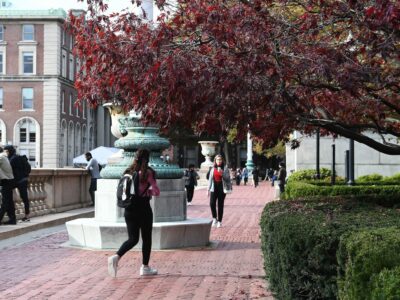It’s a Saturday morning, and most kids between the ages of 12 and 14 are sleeping in, off to rehearsals or sports team practice, or grudgingly helping with household chores. At Columbia University, a group of middle-school students are eagerly engaging in the scientific method. Their teachers are with them, working through the method as well, and guiding their students through the steps needed to research questions on how we use energy, how we can save energy, and the biodiversity that surrounds us. Even stranger: Not all the teachers teach science. In this group the majority teach music and English language arts.
Both students and teachers are participating in the Technology, Research, Ecology and Exchange for Students (TREES) Interschool Energy Project. The project is funded by the National Science Foundation and offered as part of the Center for Environmental Research and Conservation’s educational programs. The center, a unit of Columbia University’s Earth Institute, offers this unique educational opportunity to New York City public school middle- and junior-high school students in the neighborhood.
As the young scholars tour the Morningside campus, one asks the tour guide, “Can I meet a paleontologist?” and then embarks on an explanation of the cloud patterns in the afternoon sky. While we might question his specialization, his general career field seems predetermined. The future paleontologist is not an anomaly in the group, but represents the kind of excited, scientifically-minded students that have volunteered for this project—in addition to all their other student responsibilities. So what’s going on here?
What’s TREES?
The TREES Interschool Energy Project helps teachers design, implement and evaluate STEM (Science, Technology, Engineering and Math) and STEM/ICT (Information, Communication, Technology) content and teaching strategies for the study of ecology, biodiversity and environmental sustainability in urban ecosystems. The TREES program is funded through a $1.2 million, three-year grant from the National Science Foundation’s Innovative Technology Experiences for Students and Teachers Division.
Where do these students come from?
We rarely see the kind of students participating in the Interschool Energy Project walking around the environmental sciences department of most college campuses. But the working groups touring the Columbia University Morningside campus on that bright Saturday afternoon come from public schools near Columbia’s campus: JHS 52 in the heart of Inwood, Patria Mirabal Middle School (MS 324) in Washington Heights and the Bronx School of Science Inquiry and Investigation (MS 331) in the Morris Heights section of the Bronx.
The chart below highlights demographic information on these three schools: (this data was retrieved from www.insideschools.org)
| School | Hispanic | Black | Asian | White | Free Lunch | ESL |
| JHS 52 | 92% | 7% | 1% | 97.1% | 36.7% | |
| MS 324 | 86% | 11% | 1% | 95.7% | 44.2% | |
| MS 331 | 69% | 29% | 1% | 1% | 96% | 23.4% |
The racial and socio-economic make-up of this group defies stereotypical national discourse on public school student achievement. The Center for Environmental Research and Conservation is giving these students a chance to express their inner nerd, with pride. The research project topics include methods of energy conservation and energy consumption in their schools, and determining the extent of the biodiversity in their surroundings.
The Results?
Concluding research presentations will take place on May 19 to an audience of friends and families in the Northwest Corner Building of Columbia University’s Morningside Campus.
For more information on the Center for Environmental Research and Conservation and its K-12 education programs, visit: http://www.cerc.columbia.edu/?id=edu-training-k12



